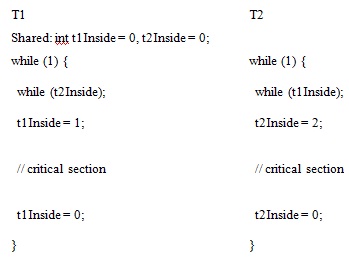Question1. Explain why interrupts are not appropriate for implementing synchronization primitive in multiprocessor systems and why spinlocks are not appropriate for single-processor systems yet are often used in multiprocessor systems.
Question2. Mutual exclusion primitives can be implemented with busy waiting or with blocking. Discuss the applicability and relative merits of each approach.
Question3. Synchronization within monitors uses condition variables and two special operation wait and signal. A more general form of synchronization would be to have a single primitive, waituntil, that had an arbitrary boolean predicate as a parameter. Thus, one could say, for example waituntil x < 0 or y+z < nThe signal primitive would no longer be needed. This scheme is clearly more general, but it is not used. Why not? Hint, think about the implementation.
Question4. Suppose there are 2 threads T1, T2. Please describe if the following solution provides the correct synchronization for critical section that satisfies three conditions: mutual exclusion, bounded wait and make progress.

Question5. Please write the pseudocode for the following problems:
1. Semaphore operation wait() and signal() implemented using block waiting.
2. Consider a pizza store which has 10 seats. A customer comes to buy pizza. If there is any unsold pizza left in the kitchen, he can get it immediately. If not, (s)he need wait for chef to make one. After the customer gets the pizza, (s)he will grab a seat and start eating. If there is no seat, (s)he needs to wait. When (s)he finishes eating, (s)h will left the store. The chef in the kitchen just keeps making pizza. However, (s)he stops if there are 5 unsold pizza left in the kitchen. If a customer come to buy one, (s)he resumes the work to make new pizza. Please write pseudocode for both customer and chef using semaphore to solve this problem, and synchronize chef and customers.
Programming Problem:
Question6. Write a multi-threaded program to solve producer and consumer problem.
- There are two types of worker thread: producer and consumer. A producer thread randomly generate an integer between 0-100 (You can use random()/srandom() or drand48()/srand48() to generate random number in C), and put it into the buffer. A consumer thread simple take the first integer from the buffer. A circular array should be used for the buffer. You do not need loop for both types of thread. Each thread will exit after only consuming or producing one item (only once).
- Assume total number of worker thread is 20, and buffer size is 10. Your program should randomly generate the number of producers and consumers. Their relationship should be : num_producers + num_consumers = num_threads, num_producer - num_consumer <= buffer_size, num_consumer <= num_producer, so that no thread will be blocked forever. The order between consumer and producer threads should be arbitrary. For example, you shall not generate all producers (consumers) and then all consumers (producers). (5 points)
- Synchronize the producer and consumer.
- You can choose any type of language (e.g. C/C++/Java) to implement this program.
Your output will look like the following:
Number of producer: 12 Number of consumer: 8
Thread 0 produce 63 in buffer 0, current number of items is 1
Thread 1 consume item 63 in buffer 0, current number of items is 0
Thread 3 produce 45 in buffer 1, current number of items is 1
Thread 5 produce 88 in buffer 2, current number of items is 2
Thread 4 consume item 45 in buffer 1, current number of items is 0
…....
…..
…...
There are still 4 items left in the buffer: 96,26,52,81
- Please check blackboard for more reference about pthread library if you choose to use it.
- Please submit all source code and a simple readme file on how to compile your code and the sample output. Please zip all files into a single zip file and submit through blackboard.
You can choose any of the following questions:
Question7. Write a program to simulate pizza store problem in problem 3.2.
Question8. Describe how spinlock is implemented in Linux kernel and how/where it is used? Please give some concrete examples, e.g. list the data structure/functions related to spinlock implementation, describe the code of some spinlock functions, and describe how to use these functions for synchronization, list the functions that use spinlocks and their purpose.